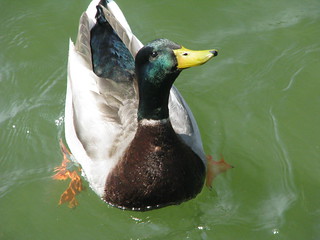Our neighbors to the north have launched a research project to study mallards and other waterfowl during their fall migration. In particular, they are trying to better understand the habitat needs of mallards, including how the habitats are affected by climate change, wind turbines and other factors. Like many other wildlife research projects, the team will use GPS technology to their advantage. They hope to fit 40 ducks with GPS collars over the three-year research period, but so far can only afford to track one.

CC Image courtesy of Joanna Lee Osbornon Flickr
The lucky duck is called Rondeau Rhonda. It is named after the Rhondeau Bay, which is a popular area for waterfowl. “There is a direct correlation between what goes on at Lake St. Clair and what goes on at Rondeau Bay in terms of waterfowl, where they rest, where they migrate,” explained Mike Moynihan, public relations representative for The Rhondeau Bay Waterfowler’s Association. RBWA donated $1,000 to the mallard research project, allowing them to afford a GPS tracking device. The device provides real-time location data, which will come in especially handy during migration.
GPS tracking is very useful in all sorts of ways. Wildlife research has benefited a great deal from the technology. Typically, when we think of wildlife research, we think of Jane Goodall getting as close as possible to the animals and their natural habitat. In many place around the world, research is still done this way. But for teams fortunate enough to access funding for GPS collars, so much more information is available.
Animals are typically very sensitive to the presence of humans. It’s a survival instinct all of us animals have. When we’re out hiking, if we hear twigs snapping along the trail or otherwise sense we are possibly being followed, our instincts are to escape. At the very least, we aren’t going to be acting naturally. This is the case for many animals in the wild that are threatened by human presence. WIth GPS collars, researchers can monitor the movements of wildlife from a safe, non-invasive distance. Some studies also include motion-detecting cameras to pair with the tracking devices, which provide a more full picture of the habitat. Otherwise, some biologists simply travel to the GPS locations to observe the trails and habitats further.
The GPS tracking data “gives us wonderful data on movement patterns and migration and everything else,” explained Dr. Scott Petrie, Long Point Waterfowl’s executive director, in an interview with The Chatham Daily News. One of the major factors leading up to this research project was the noticeable decline in mallards and their wetland homes in the Lake St. Clair region of Canada. “There’s been a drastic decline in wetland acreage in and around Lake St. Clair,” Petrie said.

CC Image courtesy of uvw916a on Flickr
The study will look at where the mallards are feeding. “We kind of think that bait ponds and flooded corn probably provide important supplemental food for waterfowl.” On the Canadian side of the Great Lakes, Lake St. Clair and Long Point are likely the most significant wetlands. “Lake St. Clair is by far the most threatened, because most of the wetlands at Long Point aren’t drainable… they’re close to wetlands that aren’t dyked,” Petrie said. “Whereas, almost every wetland at Lake St. Clair is diked and very easily drainable.”
Petrie added, “there’s financial incentive for some people to pull the plug, drain their wetlands, then grow vegetables and possibly throw wind turbines in.” Agricultural land in this region is valued from $15,000 to $20,000 per acre. “But, if you put wind turbines into very important waterfowl habitat and the waterfowl avoid those areas, then that’s tantamount to habitat loss,” he said.
The tracking information “is going to have a direct impact on what we’re going to learn about mallard migration and so on,” Moynihan added. “We have noticed over the last few years – this is prior to turbines – that mallards are arriving later and later in the year.” Waterfowl tend to give plenty of space to wind turbines. Observation show that approximately 300 meters around each turbine mallards and other water birds are not found. Meaning, the birds avoid the turbines, likely because of the huge danger their massive blades pose to flying animals. Few, brave birds can be found within a kilometer diameter, called an “avoidance zone”.
“We want to see waterfowl populations flourish and we want to see strong ecology, strong biology and so on,” Moynihan added. Unfortunately, a large factor holding back the research is funding. They have been able to raise enough funds for one GPS tracker, but they hope to raise more money to be able to track a lot more birds. The more birds tracked, the more full, accurate and useful the tracking data will be. If you’re interested in donating to the cause, email spetrie@longpointwaterfowl.org or gdunn@longpointwaterfowl.org.
GPS Trackers for Mallards

No comments:
Post a Comment